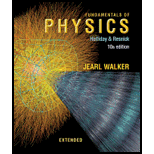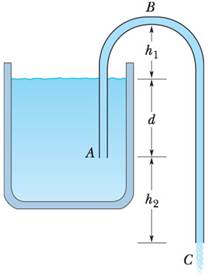
Concept explainers
Figure 14-56 shows a siphon, which is a device for removing liquid from a container. Tube ABC must initially be filled, but once this has been done, liquid will flow through the tube until the liquid surface in the container is level with the tube opening at A. The liquid has density 1000 kg/m3 and negligible viscosity. The distances shown arc h1 = 25 cm, d = 12 cm, and h2 = 40 cm. (a) With what speed does the liquid emerge from the tube at C? (b) If the atmospheric pressure is 1.0 × 105 Pa, what is the pressure in the liquid at the topmost point B? (c) Theoretically, what is the greatest possible height that a siphon can lift water?

Figure 14-56 Problem 83.
Want to see the full answer?
Check out a sample textbook solution
Chapter 14 Solutions
Fundamentals of Physics Extended
Additional Science Textbook Solutions
Physics for Scientists and Engineers: A Strategic Approach, Vol. 1 (Chs 1-21) (4th Edition)
Physics for Scientists and Engineers, Technology Update (No access codes included)
College Physics
Fundamentals Of Thermodynamics
Lecture- Tutorials for Introductory Astronomy
- Logs sometimes float vertically a lake because one end has become water-logged and denser than the other. What is the average density of a uniform-diameter log that floats with 20.0% of its length above water?arrow_forwardUsing the equation of the previous problem, find the viscosity of motor oil in which a steel ball of radius 0.8 mm falls a terminal speed of 4.32 cm/s. The densities of the ball and the oil are 7.86 and 0.88 g/mL, respectively.arrow_forwardAn oil gusher shoots crude 25.0 m the through a pipe with a 0.100-m diameter. Neglecting resistance but not resistance of the pipe, and assuming laminar flow, calculate pressure at be entrance of be 50.0-m-Iong vertical pipe. Take of the oil to be 900 kg/m3 and its viscosity to be 100(N/m2) s (or 1.00 Pa s). Note that you must take into account the pressure due to 50.0-m column of oil in pipe.arrow_forward
- The gravitational force exerted on a solid object is 5.00 N. When the object is suspended from a spring scale and submerged in water, the scale reads 3.50 N (Fig. P15.24). Find the density of the object. Figure P15.24 Problems 24 and 25.arrow_forwardFluid originally flows through a tube at a rate of 100 cm3/s. To illustrate the sensitivity of flow rate to various factors, calculate be new flow rate for following changes with all other factors remaining the same as in original conditions. (a) Pressure difference increases by a factor of 1.50. (b) A new fluid wit 3.00 times greater viscosity is substituted. (c) The tube is replaced by one having 4.00 times the length. (d) Another tube used with a 0.100 times the original. (e) Yet another tube is substituted with a radius 0.100 times the original and half length, and pressure difference is increased by factor of 1.50.arrow_forward(a) Verify that a 19.0% decrease in laminar flow through a tube is caused by a 5.00% decrease in radius, assuming that all other factors remain constant. (b) What increase in flow is obtained from a 5.00% increase in radius, again assuming all other factors remain constant?arrow_forward
- Review. The lank in Figure P14.15 is filled with water of depth d = 2.00 m. At the bottom of one sidewall is a rectangular hatch of height h = 1.00 m and width w = 2.00 in that is hinged at the top of the hatch, (a) Determine the magnitude of the force the water exerts on the hatch, (b) Find the magnitude of the torque exerted by the water about the hinges.arrow_forwardA Styrofoam slab has thickness h and density s. When a swimmer of mass m is resting on it, the slab floats in fresh water with its top at the same level as the water surface. Find the area of the slab.arrow_forwardBird bones have air pockets to reduce their weight—this also gives them an average density significantly less than that of the bones of other animals. Suppose an ornithologist weighs a bird bone air and in water and finds its mass is 45.0 g ad its apparent mass when submerged is 3.60 g (assume the bone is watertight.)(a) What mass of is displaced? (b) What is the volume of the bone? (c) What is its average density?arrow_forward
- Referring to Figure 14.20, prove that the buoyant force on be cylinder is equal to the weight of the fluid displaced (Archimedes' principle). You may assume that be buoyant force is F2F1 and that the ends of be cylinder have equal areas A. Note Eat be volume of be cylinder (and that of be fluid displaces) equals (h2h1)A .arrow_forwardWe stated in Example 11.12 that a xylem tube is of radius 2.50105 m. Verify that such a tube raises sap less than a meter by finding h for it, making the same assumptions that sap's density is 1050 kg/m3, its contact angle is zero, and its surface tension is the same as that of water at 20.0°c.arrow_forwardWhat fraction of ice is submerged when it floats in freshwater, given the density of water 0°C is very close to 1000 kg/m3?arrow_forward
 University Physics Volume 1PhysicsISBN:9781938168277Author:William Moebs, Samuel J. Ling, Jeff SannyPublisher:OpenStax - Rice University
University Physics Volume 1PhysicsISBN:9781938168277Author:William Moebs, Samuel J. Ling, Jeff SannyPublisher:OpenStax - Rice University Principles of Physics: A Calculus-Based TextPhysicsISBN:9781133104261Author:Raymond A. Serway, John W. JewettPublisher:Cengage Learning
Principles of Physics: A Calculus-Based TextPhysicsISBN:9781133104261Author:Raymond A. Serway, John W. JewettPublisher:Cengage Learning Physics for Scientists and Engineers: Foundations...PhysicsISBN:9781133939146Author:Katz, Debora M.Publisher:Cengage Learning
Physics for Scientists and Engineers: Foundations...PhysicsISBN:9781133939146Author:Katz, Debora M.Publisher:Cengage Learning College PhysicsPhysicsISBN:9781938168000Author:Paul Peter Urone, Roger HinrichsPublisher:OpenStax College
College PhysicsPhysicsISBN:9781938168000Author:Paul Peter Urone, Roger HinrichsPublisher:OpenStax College Physics for Scientists and Engineers, Technology ...PhysicsISBN:9781305116399Author:Raymond A. Serway, John W. JewettPublisher:Cengage Learning
Physics for Scientists and Engineers, Technology ...PhysicsISBN:9781305116399Author:Raymond A. Serway, John W. JewettPublisher:Cengage Learning




